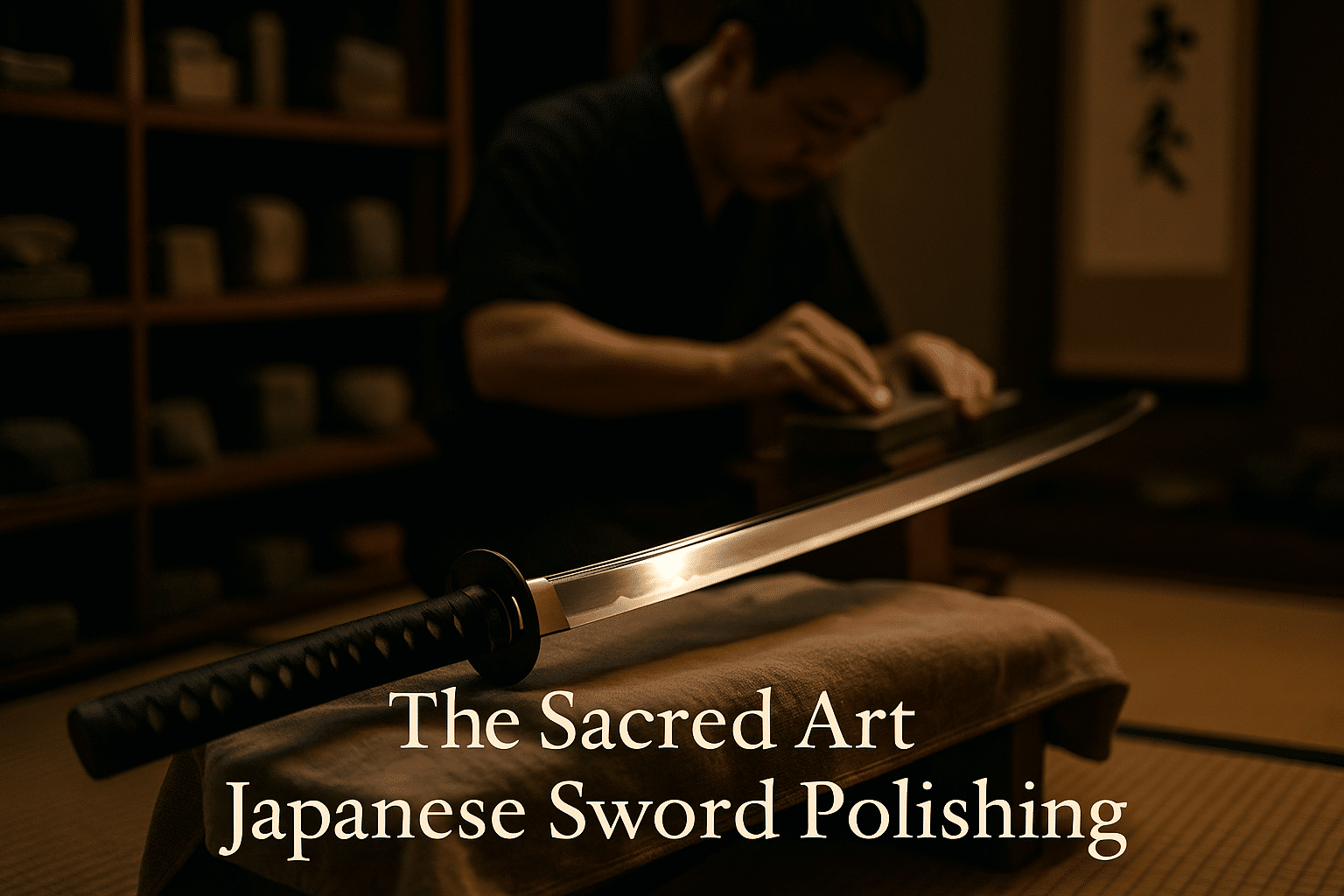Introduction: More Than a Shine
In Japan, the art of sword polishing transcends surface beauty—it is a ritual, a discipline, and a reverence passed down through centuries. To the untrained eye, it may appear as a simple act of refinishing metal, but for those who understand its depth, sword polishing is a sacred practice that breathes life back into a blade. This meticulous process is not just about restoring luster; it reveals the soul of the sword, honoring the craftsmanship of the smith and the legacy of the warrior.
Polishers, or togishi, are more than skilled artisans—they are caretakers of history. With every stroke of the whetstone, they uncover the blade’s hidden patterns, tracing the delicate hamon and the subtle artistry etched into steel. Each movement is deliberate, guided by precision, patience, and profound respect. This is not a trade learned overnight, but a lifelong devotion to form and spirit.
As we delve into the ritual of sword polishing, we step into a world where utility meets beauty, and where even the smallest detail holds symbolic weight. This is a craft that gleams not only with brilliance but with meaning.
A Legacy Passed Through Hands
In Japan, sword polishing is more than a skill—it is a sacred trust passed down through generations. The lineage of togishi, or traditional sword polishers, stretches back centuries to when the katana became not just a weapon but a symbol of the samurai spirit. For these artisans, polishing is not simply a matter of restoring shine; it is an intricate process that honors the soul of the blade and reflects the intentions of the swordsmith.
Historically, mastery of polishing was handed down within families or apprenticeships under seasoned masters. Each generation safeguarded and refined techniques developed over time, from the coarsest shaping stones to the finest uchigumori finish. The work required not only technical precision but also years of spiritual and aesthetic training to interpret the unique character hidden within each blade.
Polishers like Hon’ami Kōetsu, from the famed Hon’ami family, played pivotal roles in codifying the standards of polishing and appraisal, their influence enduring even today. The Hon’ami lineage, active since the 14th century, became trusted by daimyo and shoguns for their ability to bring out a sword’s fullest beauty without compromising its integrity.
Modern-day togishi continue this path with deep reverence. Earning the title requires over a decade of immersive apprenticeship, reflecting a philosophy that values patience, humility, and devotion to the blade. In preserving this craft, they don’t just polish steel—they polish history, spirit, and legacy.
The Sword as Spirit: Why Polishing Matters
In Japanese tradition, a sword is far more than a weapon—it is the soul of the samurai, a manifestation of spirit, craft, and lineage. Polishing a katana is not simply a matter of maintenance; it is a sacred ritual that honors this essence. Each stroke of the polisher’s hand is an act of reverence, calling forth the blade’s inner light and character. The process unveils not only the sword’s physical beauty but also its spiritual depth—patterns in the steel known as “hamon” and “hada” reflect the blacksmith’s soul and the sword’s silent history.
This meticulous practice is rooted in the belief that a sword possesses a life of its own. To polish it is to commune with that life, to tune into its quiet power and purpose. The togishi, or professional sword polisher, approaches their work with the same mindfulness as a monk in meditation—each movement deliberate, each tool an extension of a centuries-old tradition. In this, polishing becomes an art and a spiritual dialogue, blending precision and presence.
By honoring the blade in this way, practitioners don’t just preserve its edge—they renew its spirit. In every glint of polished steel lies a reflection of discipline, devotion, and the unbroken bond between sword and soul.
The Polisher: Artist and Disciple
In the traditional world of Japanese swordmaking, the polisher—known as the togishi—holds a sacred responsibility. More than a technician, the togishi is an artist and a disciple, tasked with revealing the soul of the blade forged by a master swordsmith.
Becoming a togishi demands extraordinary commitment. Apprenticeships often last a decade or more, during which the student learns not only the precise techniques of stone polishing but also the disciplined mindset passed down through generations. The process is painstaking and meditative: using a series of increasingly fine natural whetstones, the togishi brings out the subtle grain (hada) and temper line (hamon) of the steel—elements that define the blade’s aesthetic and functional integrity.
This role requires profound humility. A true togishi never seeks to impose their own vision on the blade but instead works in harmony with the sword’s form and spirit. Any error is irreversible; a blade can be ruined by a moment of over-polishing or imbalance. Thus the polisher must honor not only the craftsmanship of the swordsmith but also the history and future of the blade itself—whether it’s a centuries-old katana or a newly forged masterpiece.
In every pass of the whetstone lies a quiet ritual of reverence. The togishi is the final guardian of the sword’s beauty and legacy, illuminating its essence with the patience and precision of a true artisan.
Step by Step: The Polishing Process
The art of Japanese sword polishing, or togi, is a meticulous, multi-stage process designed not only to refine the blade’s aesthetic beauty but also to enhance its functional integrity. Carried out by trained artisans known as togishi, this ritual demands precision, patience, and years of discipline. Here’s a look at the step-by-step journey a blade undergoes during polishing:
1. Foundation Polishing (Shitaji-togi)
The process begins with foundation polishing to correct the blade’s geometry. Using coarse natural stones such as ara-to (rough stone) and binsuido, the togishi reshapes the blade slightly—cleaning up hammer marks, refining lines, and reestablishing the curve and taper with practiced strokes. This stage lays the groundwork for what follows, and any flaws here could compromise the later steps.
2. Intermediate Refinement (Kaji-togi and Chu-nagura)
Once the shape is corrected, the togishi progresses through finer stones like kaisei, chu-nagura, and koma-nagura. These abrasives systematically reduce scratches left by previous stones and begin enhancing the surface. Subtle features—such as the ridgelines (shinogi)—become more defined, and the blade’s edge gains clarity.
3. Show Polishing (Shiage-togi)
Here, the aesthetic truly emerges. Using extremely fine-grit stones like uchigumori and hazuya, the togishi carefully draws out the grain pattern (hada) and the hamon—the temper line unique to each sword. These elements aren’t etched or applied; they’re coaxed into visibility through touch and technique. This stage demands not only technical mastery but also artistic sensitivity.
4. Final Finishing (Migaki and Nugui)
The mirror finish is achieved through migaki, where the blade is burnished with specialized tools, such as hardened steel rods or deer horn. This step creates a brilliant polish on specific areas, especially the sides of the blade (shinogi-ji). For the darker, matte sections, the togishi applies nugui, a fine iron oxide blend that subtly enhances the contrast of the folded steel pattern and hamon.
Each stage is a ritual in precision, respecting the swordsmith’s original vision while revealing the blade’s hidden soul. From rough shaping to radiant shine, polishing transforms a functional weapon into a historical and artistic masterpiece.
Tools of Stillness and Precision
In the art of Japanese sword polishing, tools are not just implements—they are extensions of the polisher’s intention, selected with meticulous care to reveal the sword’s essence. Central among these are natural whetstones, prized for their unique textures and mineral compositions. Each stone performs a specific task in the multi-stage process, from rough shaping to the final mirror-like luster, guiding steel toward its true form with measured strokes.
Complementing the stones are fine polishing powders made from natural materials like deer antler or horn, which are mixed with water to gently coax out the sword’s layered grain and hamon—the temper line that tells the story of the blade’s creation. Polishing cloths, often made from soft cotton or silk, are used to apply and refine these powders, their fibers catching even the slightest irregularity.
These instruments demand stillness and unwavering focus. The polisher, in almost meditative silence, channels decades of learned skill into every motion. Each chosen tool harmonizes with the sword’s unique character, not merely perfecting its surface, but awakening the soul of the blade hidden beneath.
Preserving the Blade and the Way
In modern Japan, the intricate art of sword polishing—once passed from master to pupil under the shadow of the forge—is now upheld by a tightly knit community of dedicated artisans. These togishi not only preserve the technique but also carry forward the philosophical heart of the discipline: to reveal the sword’s soul, not merely sharpen its edge.
Apprenticeship remains central to this preservation. Young polishers undergo years, often decades, of intense training, beginning with the most basic tasks: observing tools, cleaning the workspace, and mastering the rhythm of wet stones. Only after internalizing the aesthetic and spiritual dimensions of the craft do they progress to handling blades. This slow, deliberate process ensures the integrity of transmission—not just of technique, but of humility, patience, and reverence for the sword’s history.
Modern togishi also balance innovation with tradition. While some use digital tools for documentation or precision measurement, they remain steadfast in maintaining centuries-old methods for actual polishing. Preservation doesn’t mean stagnation; it means honoring intent while adapting carefully to ensure continuity.
Above all, there is a deep sense of custodianship. Each polisher views their work as a collaboration with generations past and future—a sacred responsibility to protect not only the sword’s physical form but its cultural essence. In their hands, ancient steel continues to speak, gleam, and endure.





